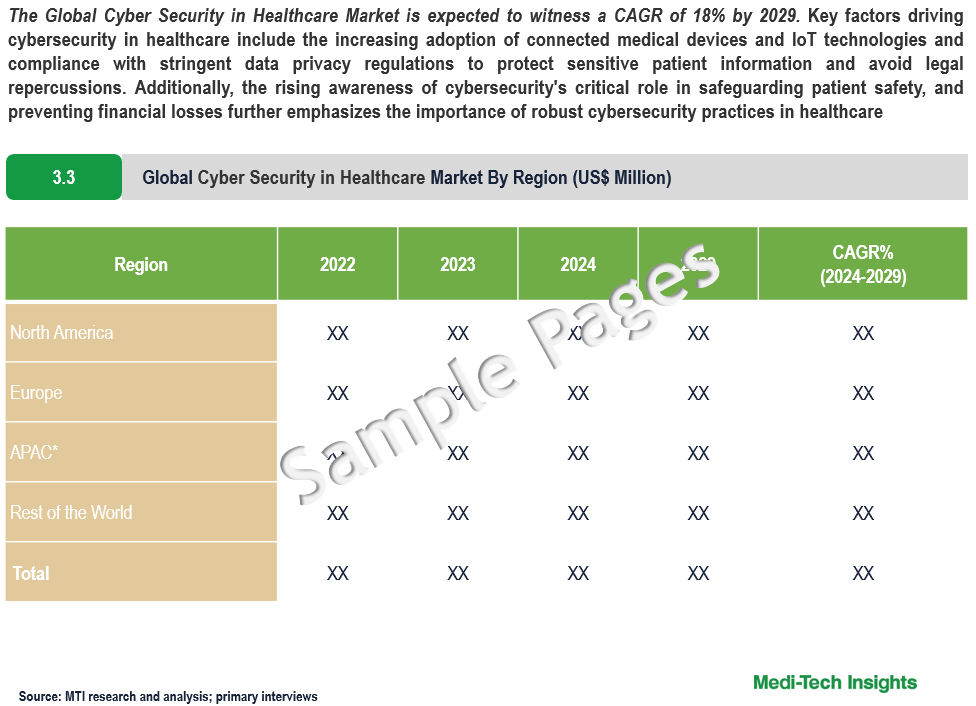
Cyber Security in Healthcare Market Size, Share, Industry Trends, Growth Analysis and Forecasts 2024 to 2029
The Global Cyber Security in Healthcare Market is expected to witness a CAGR of 18% by 2029. Key factors driving cybersecurity in healthcare include the increasing adoption of connected medical devices and IoT technologies and compliance with stringent data privacy regulations such as HIPAA and GDPR also drive cybersecurity efforts to protect sensitive patient information and avoid legal repercussions. Additionally, the rising awareness of cybersecurity’s critical role in safeguarding patient safety, maintaining operational integrity, and preventing financial losses further emphasizes the importance of robust cybersecurity practices in the healthcare sector. To learn more about the research report, download a sample report.
Cybersecurity in healthcare involves protecting healthcare information systems, devices, and sensitive patient data from cyber threats. This includes safeguarding electronic health records, medical devices, and hospital networks from unauthorized access, data breaches, and ransomware attacks. Key aspects include data protection through encryption and access controls, network security using firewalls and secure protocols, and device security to prevent exploitation of connected medical devices. Compliance with regulations like HIPAA is essential, as is having robust incident response plans to handle cyber incidents. Additionally, educating healthcare staff on cybersecurity best practices and managing third-party risks are crucial for comprehensive protection.
The Growing Need for Robust Cybersecurity in Healthcare
The healthcare cybersecurity market is experiencing significant growth due to several crucial factors. The increasing adoption of connected medical devices, such as IoT-enabled monitors and diagnostic tools, has expanded the potential attack surface, making robust cybersecurity measures essential. Protecting medical devices and health IT systems from cyber-attacks is essential to ensure patient safety and maintain the integrity of healthcare operations. Safeguarding sensitive patient data from breaches and unauthorized access is crucial for maintaining patient confidentiality and trust. Regulatory compliance remains a major driver, with stringent regulations like GDPR, HIPAA, and CCPA requiring robust cybersecurity protocols. Moreover, there is a growing recognition within the healthcare industry of the critical importance of proactive cybersecurity measures, driven by the understanding that cyber-attacks can compromise patient safety, disrupt healthcare services, and lead to substantial financial losses.
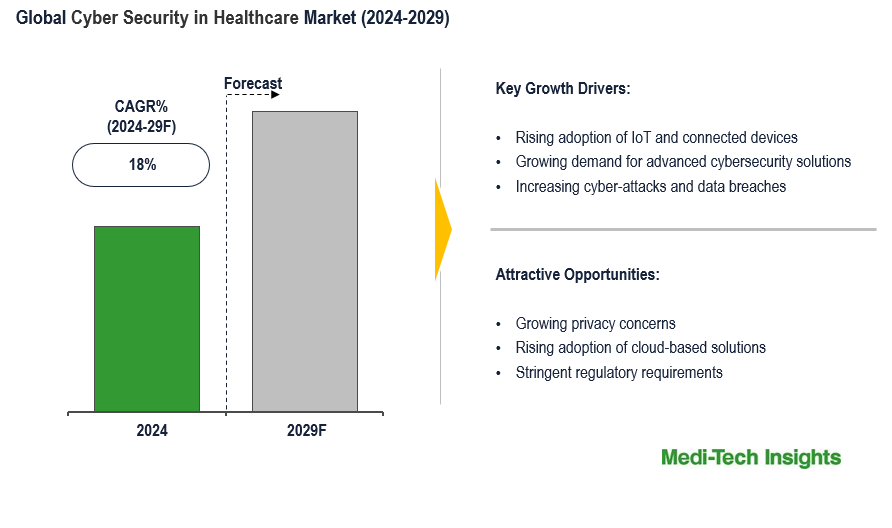
To learn more about this report, download the PDF brochure
Advanced Technologies and Trends Shaping Modern Cybersecurity
Modern cybersecurity is shaped by several key trends. The increasing threat landscape, characterized by the rising frequency and sophistication of cyber-attacks such as ransomware, phishing, and advanced persistent threats, demands heightened security measures. The rapid digital transformation, with widespread adoption of digital technologies, cloud services, and IoT devices, has significantly expanded the attack surface. Economic impact also plays a crucial role, as financial losses from data breaches and cyber-attacks underscore the need for strong cybersecurity practices. The growing need for healthcare cybersecurity presents numerous opportunities. Implementing advanced technologies like AI, machine learning, and blockchain can enhance threat detection, automate responses, and ensure data integrity. For instance,
- In June 2024, Trend Micro showcased its integration of NVIDIA NIM inference microservices from the NVIDIA AI Enterprise software platform, unveiling new security solutions like Trend Vision One SPC, Companion, and ASRM, designed to secure AI data centers and enhance cloud cybersecurity at COMPUTEX in Taipei
- In March 2024, at the annual HIMSS24 conference, Claroty announced the release of the Advanced Anomaly Threat Detection (ATD) Module within the Medigate Platform, providing healthcare organizations with the clinical context to identify, assess, and prioritize threats to connected medical devices, IoT, and building management systems (BMS)
The expansion of telehealth services opens opportunities for securing remote consultations and patient data transmission. Developing comprehensive security frameworks that integrate with existing healthcare IT systems can provide more effective protection. Offering specialized cybersecurity training for healthcare staff and creating robust protocols for managing third-party risks are also key opportunities. These advancements and strategic initiatives can significantly bolster the cybersecurity posture of the healthcare sector.
Comprehensive overview of the Healthcare Cybersecurity Market: Solutions and Services Segments
The healthcare cybersecurity market is divided into solutions and services. Solutions, such as advanced cybersecurity software, firewalls, antivirus, encryption tools, and intrusion detection systems, dominate the market, driven by the adoption of connected medical devices and compliance needs. Services, including managed security services, consulting, and training, are also crucial. Managed security services are particularly in demand for continuous monitoring; while consulting and training services help healthcare organizations implement effective security strategies and educate staff on best practices. Both segments highlight the importance of comprehensive cybersecurity measures in the healthcare sector.
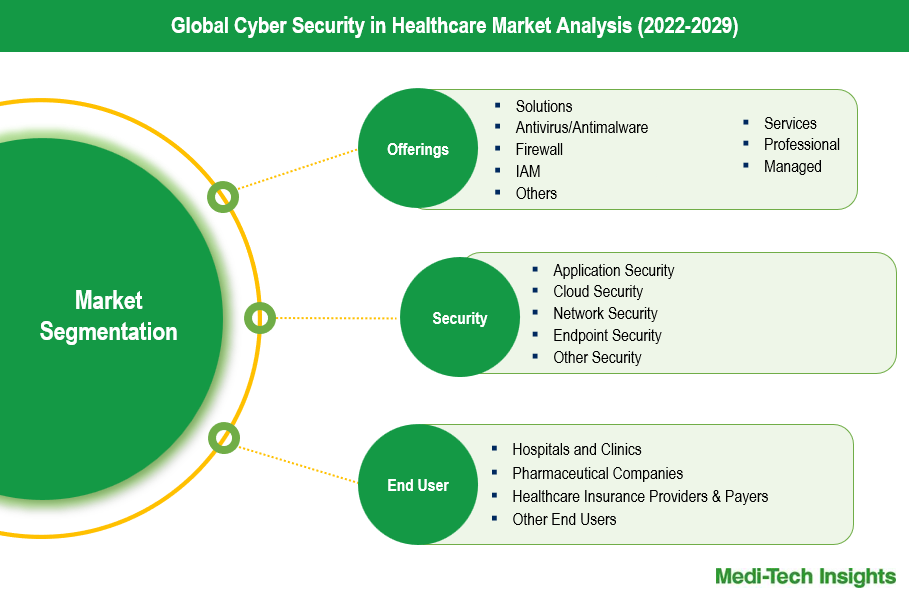
To learn more about this report, download the PDF brochure
Comprehensive overview of the Healthcare Cybersecurity Market: End User Segment
The healthcare cybersecurity market end-user segment includes hospitals, clinics, pharmaceutical companies, and healthcare payers. Hospitals represent the largest segment due to their vast networks of connected devices and extensive patient data, necessitating robust cybersecurity measures to protect sensitive information and ensure uninterrupted medical services. Clinics, although smaller, also require strong cybersecurity to safeguard patient records and comply with regulations. Pharmaceutical companies are increasingly adopting cybersecurity solutions to protect intellectual property, secure research data, and comply with stringent regulatory standards. Healthcare payers, such as insurance companies, need advanced cybersecurity to protect vast amounts of sensitive data and manage complex transactions securely. Each of these end-user segments highlights the critical need for tailored cybersecurity solutions to address their unique challenges and vulnerabilities.
Competitive Landscape Analysis: Cyber Security in Healthcare Market
Some of the key and established players operating in the global cyber security in healthcare market are Cisco Systems, Inc., IBM, Trellix, Accenture, Trend Micro Incorporated, McAfee, LLC., Intel Corporation, AO Kaspersky Lab, Palo Alto Networks, Northrop Grumman, Imperva (acquired by Thales), Fortinet, Inc., and Medigate (Claroty) among others.
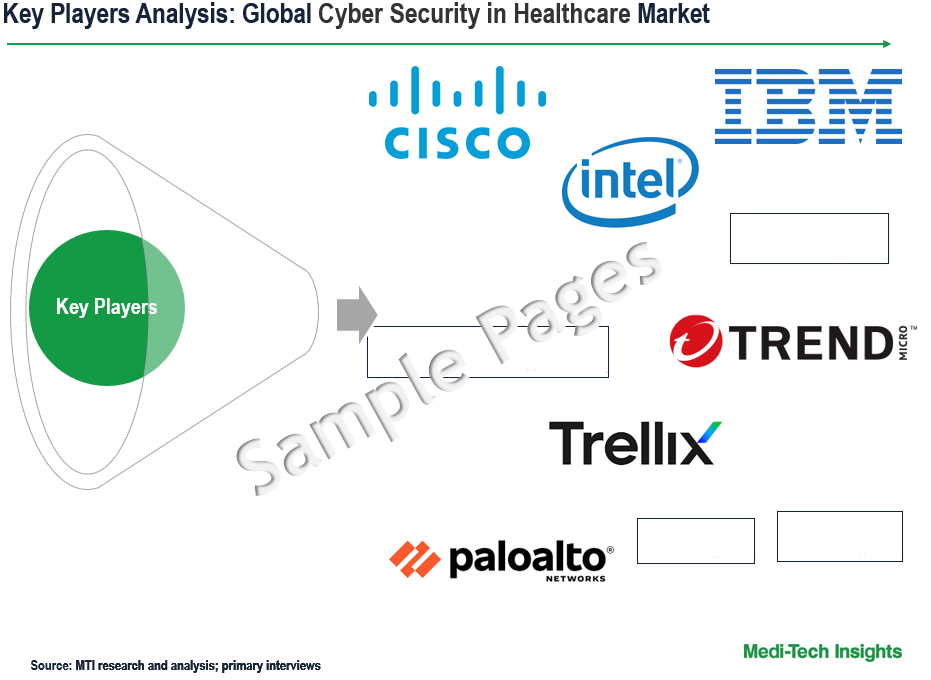
Get a sample report for competitive landscape analysis
Organic and Inorganic Growth Strategies Adopted by the Leading Market Players to Establish Their Foothold in the Global Cyber Security in Healthcare Market
Leading players operating in the global market are adopting both organic and inorganic growth strategies such as launching new services, acquiring related firms, and entering into collaborations to garner a higher market share.
For instance,
- In June 2024, Fortinet, announced its definitive agreement to acquire Lacework, a data-driven cloud security company, integrating its AI-powered Cloud-Native Application Protection Platform (CNAPP) into the Fortinet Security Fabric, thereby accelerating its growth strategy
- In December 2023, IBM Consulting and Palo Alto Networks announced an expanded strategic partnership aimed at enhancing clients' abilities to fortify their comprehensive security strategies and effectively address evolving security threats
- In December 2023, Cisco introduced the Cisco AI Assistant for Security, enhancing the AI-driven capabilities of its Security Cloud platform to help customers make informed decisions, augment tool capabilities, and automate complex tasks
- In December 2023, Thales acquired US-based Imperva, enhancing its cybersecurity business and expanding into the data security and application security markets
- In December 2023, IBM Consulting and Palo Alto Networks announced the expansion of their strategic partnership to help clients enhance their end-to-end security postures and navigate evolving security threats more effectively
Global Cyber Security in Healthcare Market is expected to gain further momentum in the upcoming years due to growing demand for advanced cybersecurity solutions, stringent regulatory policies and aggressive organic and inorganic growth strategies followed by the key market players.
Cyber Security in Healthcare Market Scope
| Report Scope | Details |
| Base Year Considered | 2023 |
| Historical Data | 2022 - 2023 |
| Forecast Period | 2024 - 2029 |
| CAGR (2024-2029) | 18% |
| Segment Scope | Offerings, Security and End User |
| Regional Scope |
|
| Key Companies Mapped | Cisco Systems, Inc., IBM, Trellix, Accenture, Trend Micro Incorporated, McAfee, LLC., Intel Corporation, AO Kaspersky Lab, Palo Alto Networks, Northrop Grumman, Imperva (acquired by Thales), Fortinet, Inc., and Medigate (Claroty) among others |
| Report Highlights | Market Size & Forecast, Growth Drivers & Restraints, Trends, Competitive Analysis |
Key Strategic Questions Addressed
-
What is the market size & forecast for the Global Cyber Security in Healthcare Market?
-
What are the historical, present, and forecasted market shares and growth rates of various segments and sub-segments of the Global Cyber Security in Healthcare Market?
-
How has COVID-19 impacted the Global Cyber Security in Healthcare Market?
-
What are the major growth drivers, restraints/challenges impacting the market?
-
What are the opportunities prevailing in the market?
-
What is the investment landscape?
-
Which region has the highest share in the global market? Which region is expected to witness the highest growth rate in the next 5 years?
-
Who are the major players operating in the market? What is the competitive positioning of key players?
-
Who are the new players entering the market?
-
What are the key strategies adopted by players?
- Research Methodology
- Secondary Research
- Primary Research
- Market Estimation
- Market Forecasting
- Executive Summary
- Market Overview
-
- Market Dynamics
- Drivers
- Restraints
- Key Market Trends
- Industry Speaks
- Market Dynamics
- Key Revenue Pockets
- Global Cyber Security in Healthcare Market - Size & Forecast (2021-2028), By Offerings
- Solutions
5.1.1 Antivirus / Antimalware
5.1.2 Risk and Compliance Management
5.1.3 Identity and Access Management (IAM)
5.1.4 Firewall
5.1.5 Distributed Denial of Service (DDoS) Mitigation
5.1.6 Security Information and Event Management
5.1.7 Other Solutions
- Services
5.2.1 Professional Services
5.2.2 Managed Services
- Global Cyber Security in Healthcare Market - Size & Forecast (2021-2028), By Security Type
- Application Security
- Cloud Security
- Network Security
- Endpoint Security
- Other Security Types
- Global Cyber Security in Healthcare Market - Size & Forecast (2021-2028), By End User Type
- Hospitals & Clinics
- Pharmaceutical Companies
- Healthcare Insurance Providers & Payers
- Other End Users
- Global Cyber Security in Healthcare Market - Size & Forecast (2021-2028), By Region
- North America (U.S. & Canada)
- Europe (UK, Germany, France, Italy, Spain, Rest of Europe)
- Asia Pacific (China, India, Japan, Rest of Asia Pacific)
- Rest of the World (Latin America, Middle East & Africa)
- Competitive Landscape
- Key Players and their Competitive Positioning
- Competitive Positioning of Key Players (2022)
- Offerings Assessment, By Player
- Key Strategies Assessment, By Player (2021-2023)
- New Product & Service Launches
- Partnerships, Agreements, & Collaborations
- Mergers & Acquisitions
- Geographic Expansion
- Key Players and their Competitive Positioning
- Key Companies Scanned (Indicative List)
- Cisco Systems, Inc.
- IBM
- Trellix
- Accenture
- Trend Micro Incorporated
- McAfee, LLC.
- Intel Corporation
- AO Kaspersky Lab
- Palo Alto Network
- Northrop Grumman
- Imperva (Thales)
- Fortinet, Inc.
- Medigate (Claroty)
- Other Prominent Players
The study has been compiled based on extensive primary and secondary research.
Secondary Research (Indicative List)

Primary Research
To validate research findings (market size & forecasts, market segmentation, market dynamics, competitive landscape, key industry trends, etc.), extensive primary interviews were conducted with both supply and demand-side stakeholders.
Supply Side Stakeholders:
- Senior Management Level: CEOs, Presidents, Vice-Presidents, Directors, Chief Technology Officers, Chief Commercial Officers
- Mid-Management Level: Product Managers, Sales Managers, Brand Managers, Business Development Managers, Consultants
Demand Side Stakeholders:
- Stakeholders in Hospitals and Clinics, Pharmaceutical Companies, Healthcare Insurance Providers & Payers and Other End-users
Breakdown of Primary Interviews
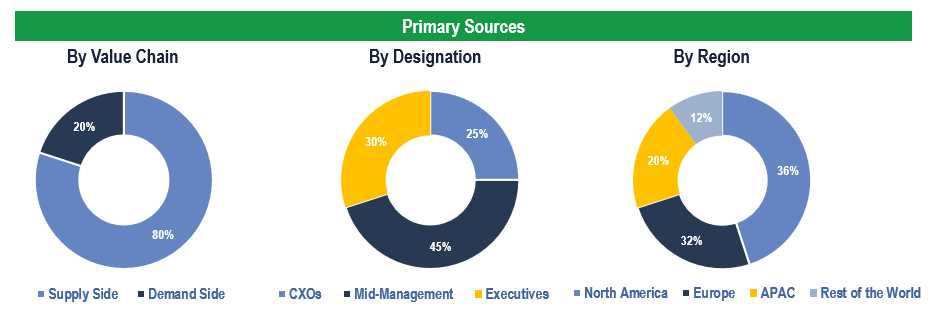
Market Size Estimation
Both ‘Top-Down and Bottom-Up Approaches’ were used to derive market size estimates and forecasts.
Data Triangulation
Research findings derived through secondary sources & internal analysis were validated with Primary Interviews, Internal Knowledge Repository, and Company Sales Data.

